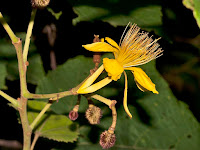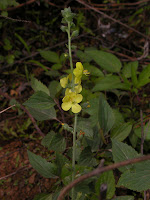
Hitchenia caulina

Curcuma longa

Curcuma pseudomontana

Curcuma neilgherrensis
FAMILY OF THE WEEK : ZINGIBERACEAE
A family of 45 genera and 750 species distributed in the tropical regions chiefly Indo Malaysia. In India there are 17 genera and 112 species occurring in Eastern Himalayas and Western ghats.
Vegetative characters:
The aerial stem when present is short and leafy or scapose and bearing only flowers as in Curcuma and Zingiber. The leaves are basal or cauline and are in two rows. They have a sheathing base and a petiole may or may not present between sheath and blade. The blade is linear to ellipticand often large with numerous closely parallel and pinnate veins diverging obliquely from the midrib. A characteristic ligule is present at the junction of the petiole and blade.
Inflorescence and flowers:
The flowers are bracteate and the bracts are often coloured and distichous or spirally arranged. They are mostly bisexual, zygomorphic or actinomorphic, trimerous and epigynous. The perianth is of six members in two trimerous whorls. It is differentiated into an outer calyx and and an inner corolla. The three sepals are united into a tube. The odd sepal is anterior. The petals are also more or less united and the three segments are similar or dissimilar and then the posterior segment is usually the largest and covers the edges of lateral segments. The petals are often very showy and delicate. The androecium is of six stamens in two trimerous whorls. The anterior stamen of the outer whorl is always absent while the other two are represented by large and leafy staminodes. The posterior stamen of the inner whorl and the other two are united to form a petaloid labellum which embraces the fertile stamen and is often the most conspicuous part of the flower. The fertile stamen and the staminodes are inserted on the mouth of the corolla tube. The fertile stamen has a slender and deeply grooved filament and a dithecous anther dehiscing vertically. The gynoecium is tricarpellary and syncarpous. The ovary is inferior and trilocular.The style is simple and terminal and is more or less enevoloped in the groove of the filament of the fertile stamen. Sometimes the style is two lipped or dentate. The stigma is simple or capitate.
A pair of nectar secreting epigynous glands are often present.
Fruits and seeds:
Pollination and dispersal:
Examples:
Curcuma
Curcuma longa L. (Turmeric,Haldi)
Curcuma angustifolia Roxb.(East Indian arrowroot, Tikhur)
Curcuma neilgherrensis
Amomum cardamomum (Cardamum,Choti Elayachi)
Elettaria cardamomum (Cardamon, Elaychi)
Hitchenia caulina




.jpg)




































